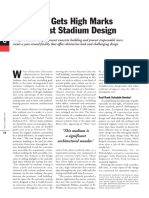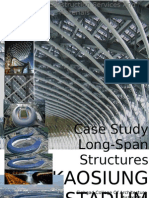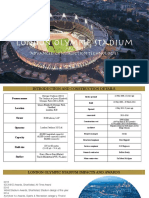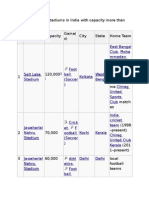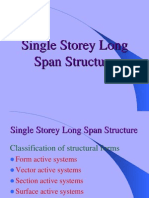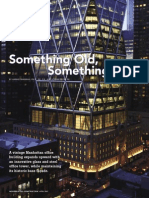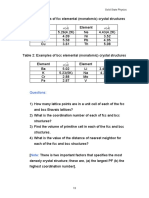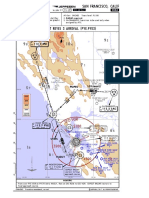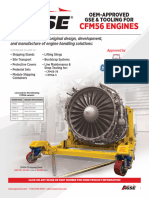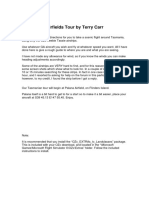The Retractable Roof and Movable Field at University of Phoenix Stadium Arizona
The Retractable Roof and Movable Field at University of Phoenix Stadium Arizona
Uploaded by
Heitham Bou ChahineCopyright:
Available Formats
The Retractable Roof and Movable Field at University of Phoenix Stadium Arizona
The Retractable Roof and Movable Field at University of Phoenix Stadium Arizona
Uploaded by
Heitham Bou ChahineOriginal Title
Copyright
Available Formats
Share this document
Did you find this document useful?
Is this content inappropriate?
Copyright:
Available Formats
The Retractable Roof and Movable Field at University of Phoenix Stadium Arizona
The Retractable Roof and Movable Field at University of Phoenix Stadium Arizona
Uploaded by
Heitham Bou ChahineCopyright:
Available Formats
The Retractable Roof and Movable Field at University of Phoenix Stadium, Arizona
Mark C. Waggoner, Principal, Walter P Moore, Austin, Texas, USA
Introduction
University of Phoenix Stadium in Glendale, Arizona, USA is one of the first in a second generation of US multipurpose stadium venues that serve both the primary sports tenant and the community that funded the stadium construction. Built as the first permanent home of the Arizona Cardinals National Football League (NFL) franchise, the stadium also hosts the Arizona Sports and Tourism Authority (AZSTA) as an equal cotenant charged with utilizing the venue facilities beyond the eight NFL game days each year. Central to the design program was the ability for the building to be functional, flexible, and rapidly adaptable to the needs of both tenants, while demonstrating a world-class architectural design. Enabling the rapid adaptability of the stadium are two key kinetic structures. The 46 000 sq.m, 213 m span roof structure includes a 9000 sq.m movable roof that retracts to create an opening over the playing field. In addition, the playing field is mounted inside a giant movable tray structure that glides out of the south end of the stadium to reveal a state-of-the-art trade show floor. This article describes the structural design and construction of the roof and field structural systems. Keywords: long-span roof; retractable roof structures; steel construction; kinetic architecture; operable pitch; roof lift erection method; strand jacking; vibration.
Fig. 1: University of Phoenix stadium exterior view
challenged to develop an opening for the retractable roof that was only just large enough to give the feel of outdoor play with the roof open in order to control the roof mechanization costs and retain a slender profile of the movable roof panels.
The final roof solution (Fig. 2) created a roof opening of 74 m 110 m framed by two large lenticular trusses spanning 213 m along the long direction of the field to four large inset structural concrete columns. This solution was driven by the need to provide a stiff
Roof Design
A key aspect of the formal architectural concept (Fig. 1) was that the roof mass presents a relatively low-rise form that did not visually dominate the unique building skin below. These requirements translated to a 16 m allowable rise over an eave perimeter span of 250 m, a ratio unacceptable to realize traditional dome action economically. At the same time, the design team was
Fig. 2: University of Phoenix stadium roof structural system
Structural Engineering International 1/2008
Structures in North America
11
line of support directly beneath the movable roof panels and the suitability of the lenticular form to the architectural constraints. The upper 16 m of the 26,5 m total lenticular form depth could stick up above the stadium eave to form the roof surface, while the remainder could be tucked beneath the roof, yet stay above the spectator sightlines. The use of discrete, linear spanning primary elements versus two-way systems that require the entire roof form to be completed on shores also proved advantageous for constructability. At an early stage of the design, the roof erector proposed to build the primary trusses and all framing between them on the ground and jack the entire assembly into place. The entire structural design was subsequently worked around this roof erection concept, in a unique and rewarding collaboration between engineer and contractor.
the planes of x-bracing existed on each face of the truss, it was possible to introduce a single horizontal connecting rod at the central crossing point of the rod pairs. With the main rods installed straight to their fixed length, an induced catenary action was created by tensioning the single draw-in rod to 3,5 kN, simultaneously producing 23 kN of prestress in each of four sets of rod pairs. The remainder of the fixed roof consists of relatively conventional secondary trusses of welded wide-flange shapes that span between Brunel trusses and to the exterior stadium perimeter. A panelized roof surface between secondary trusses consists of custom joist girders at 10 m centers supporting conventional joists and metal deck. Sized deeper than necessary for their 20 m span, the stiffness of the joist girders was utilized as the primary stability system for the secondary trusses through torsional bracing, eliminating the need for costly horizontal bracing systems in the roof plane. Lateral loads on the roof structure result from conventional unbalanced and drag wind loads as well as the impact and braking requirements of the retractable roof panels. The Brunel Trusses are hard connected to both supercolumns along their longitudinal axis in order to share the large braking and impact forces. Restraint forces from temperature changes are readily handled through vertical deformation of the Brunel Truss combined with horizontal flexibility of the cantilevered supercolumns. Perpendicular to the Brunel Trusses, each secondary truss is hard connected to the adjacent bowl structure. Because of their pitch, the secondary trusses develop thrusting action under applied load. A series of staged lateral connections during erection allowed elimination of thrusting loads that would be undesirable for the bowl concrete frames from roof dead load, while the thrust forces from imposed roof loading were readily transferred.
ylene (PTFE)-coated fiberglass tensioned fabric forms the panel cladding, allowing a significant amount of light into the building. Each retractable roof panel consists of eight trusses riding on four carriers at each panel support line. Taking a cue from the Brunel Trusses, the retractable trusses are also lenticularly shaped, but use a vierendeel system to resist unbalanced loads. The truss chords consist of 355 mm square rolled HSS shapes, with closely spaced vertical HSS shape web members. Relatively simple moment connections create the vierendeel system. Adjacent trusses are joined by horizontal bridging elements at top and bottom chords, which connect to horizontal trusses between the truss pairs at each end of the panel. Diagonal members in a vertical plane were intentionally avoided in order to present a regular orthogonal grid of framework that avoids the cluttered appearance of most long-span systems with repetitive trusses (Fig. 3). The retractable roof mechanization system is shown in Fig. 4. Each pair of retractable trusses sits atop a single two-wheeled carrier, allowing predictable load distribution without a mechanical suspension system. The two 1 m diameter wheels at each carrier ride along a continuous 175 lb hardened crane rail. Of the four carriers along each panel edge, two are powered and two are idler carriers. A cable drum is mounted to the powered carriers and rides with the panel as it moves along the sloping rail. Two wire rope cables, one on each side of the rail, connect from each cable drum to a fixed attachment point at the center peak of the Brunel Trusses. To open the roof, the cables simply unwind from the cable drum at a controlled rate as the weight of the structure drives the panel downhill. The cables are wound back onto the drum to close the roof.
Roof Structural System
In deference to the similarity of their lenticular form to I.K. Brunels 1859 Royal Albert Bridge, the primary spanning roof elements were dubbed Brunel Trusses. Of course, these elements do not act at all like a traditional truss, but rather a self-resolving superposition of an arch and a catenary tension element separated by compression struts. Only light diagonal rod x-bracing is required in the webs to resist unbalanced loads. As a result, the large, complex, and unsightly gusset plate connections typically associated with massive trusses are avoided entirely. The top chord of the Brunel truss consists of a 4,5 m square box truss fabricated of wide-flange shapes and laced with double angle members. Each top chord segment is joined to the next through simple end plate compression bearing plates. A pair of Hollow Structural Section (HSS) struts arranged in a V configuration connect the top and bottom chords. The bottom chord tension element consists of a pair of jumbo wide flange shapes spliced with relatively simple bolted connections. Due to various unbalanced loading cases from wind loads and potential retractable panel locations, each of the x-bracing rods could experience load reversals and thus required significant prestress. Conventional in-line prestressing methods would have been time consuming to accomplish in the erected position of the trusses. Because
12 Structures in North America
Roof Erection
At the stadium jobsite both Brunel Trusses, the fixed trusses that span between them, and the operable roof panels were assembled on the ground, roughly 37 m below their final position. The ability to assemble the largest components of the roof nearly on the ground with simple scaffold and manlift access greatly speeded assembly and created an extremely safe working environment for the ironworkers.
Retractable Roof Panel Structure and Mechanization
The retractable portion of the roof consists of two 55 m wide 79 m span panels that bi-part about the center of the field. Each panel rides along the sloping top surface of the Brunel Truss in a departure from past US retractable roofs, which have all previously ridden on flat rails. Polytetrafluoroeth-
Structural Engineering International 1/2008
Fig. 3: Retractable roof structure
Fig. 4: Retractable roof mechanization system
Because the erection intent was known at the outset of the project, the effects of the roof lift in the distribution of the internal dead load stresses was able to be considered through a nonlinear staged construction structural analysis that explicitly modeled the exact erection sequence. The temporary conditions during the roof lift and subsequent erection steps were also considered early in the process. Such measures included a separate wind tunnel test of only the roof lift assembly. Stability of the system both during and after the lifting process was provided by a giant temporary x-brace that was created at the mid-span of the roof to function as a torsional brace. A temporary laced box strut connected the bottom chords, while special temporary connections were made to allow four of the operable roof trusses to serve as a strut connecting the top chords. Temporary strand cables formed the cross bracing. The 6000 t roof lift was successfully completed over five days in late February 2005 (Fig. 5). The roof was lifted by two strand jacks installed atop each of the four supercolumns. At its peak, the strand jack system lifted the roof at 6 m/h. Movement and strain behavior of the roof were monitored throughout the lift using an extensive array of wireless monitoring equipment. Following completion of the roof lift, the remainder of the roof was erected through more conventional crane lifts from the exterior of the stadium.
could be converted to a convention floor in a single day, it became obvious that despite a greater initial cost a mechanized playing field provided the only solution to achieve the venue flexibility desired at the stadium. A 71 m 123 m movable field tray was developed that slid from its position inside the stadium along 13 steel rail lines to sit outside the south end of the stadium where the grass could grow in the ample Arizona sun (Fig. 6). A relatively simple structural grid supports the weight of the soil and turf through a series of twin composite steel beams spanning to single wheel boxes. Twelve rail lines are embedded flush with the event slab, while the central rail is upset and serves to guide the tray into the stadium. 38 drive wheels were located along each outer rail, providing a wellproportioned traction drive system
that also allows easy access from the exterior for maintenance. This system requires only 76 horsepower to move the 10 500 t field in just 1 h. Horizontal rollers at the guide rail keep the entire field tray tracking in a straight line into the building. These rollers ride in a groove in the event slab, which is filled in by kerf covers when the stadium is outside of the building. Each roller is fixed horizontally to the side of the rail head through spring loaded assemblies, which allow distribution of peak loads between guide rollers. Extensive structural analysis of the interaction of the rigid in-plane tray structure with potential misalignment of the central guide rail was conducted to determine the guide roller design loads. Because the weight of the field tray had been optimized to allow an economical and fast-operating mechanization sys-
Movable Field Tray Design
In studying various options for providing a natural grass playing field that
Fig. 5: Roof lift Structures in North America 13
Structural Engineering International 1/2008
Fig. 6: Movable field tray
tem, the steel structure that supported the surface was susceptible to transmitting undesirable vibrations. The players themselves would never be bothered by the floor vibrations while playing since their bodies are already experiencing accelerations far in excess of what the floor might cause. However, the stationary coaches and officials, as well as the players lined up for a play with a man in motion, could be distracted if the field bounced noticeably. Though the field could never provide the same feel as playing on solid ground, it had to be sufficiently stiff that it did not become a distraction to the game. Though extensive design guidance exists for evaluation of typical building systems for vibration performance, no published information was available that might set out acceptable performance for a professional sports floor. While established analytical methods could be extended to reasonably predict accelerations, the acceleration acceptance limits that exist for other building types could not be applied. A series of tests on mock-ups of the proposed system were conducted to establish an acceptable design. Each mock up was instrumented with accelerometers and subjected to both simulated football activity as well as more controlled excitation through a shaker
device. The results provided a valuable assessment of the dynamic response and damping characteristics including the drainage, soil, and turf media. Of most benefit though was the ability to demonstrate actual performance to the team representatives that would in the end use the field. This testing process pointed to an optimum combination of structural stiffness, drainage system depth, and soil depth that provided a superior kinematic experience for the players.
SEI Data Block Owner: Arizona Cardinals Arizona Sports and Tourism Authority Architects: Eisenman Architects, New York, NY, USA HOK SVE, Kansas City, MO, USA Structural Design: Walter P Moore, Austin, TX and Tampa, FL, USA Mechanization: Uni-Systems, Minneapolis, MN, USA Field Vibration Consultant: Dr Tom Murray and Dr Mehdi Setareh, Virginia Tech University, Blacksburg, VA, USA Construction Manager: Hunt Construction Group, Phoenix, AZ, USA Roof Steel Fabrication and Erection: Schuff Steel, Phoenix, AZ, USA Roof Fabric: Taiyo Birdair, Amherst, NY, USA Steel (t): Total cost (USD million): Service Date: 7700 425 (hard cost) August, 2006
Conclusion
The adaptability made possible by the retractable roof and playing field has enabled University of Phoenix Stadium to host over 180 events in its first year of operation. With the ability to host a trade show the day after an NFL game, the stadium has already influenced the design of future venues by demonstrating how well-engineered kinetic structures can greatly enhance revenue generating capacity with relatively modest initial investments. Developments in kinetic structure technology for movable roofs, walls, stands, and other major structural elements will allow future venues to build on the example set at University of Phoenix Stadium through even more robust venue flexibility.
14
Structures in North America
Structural Engineering International 1/2008
You might also like
- A320 Fcom Vol1Document1,546 pagesA320 Fcom Vol1trialeras3506100% (14)
- Long Span Structure London VelodromeDocument20 pagesLong Span Structure London VelodromeArjun Nambiar67% (3)
- Stadium AtlasDocument17 pagesStadium AtlasNeeraj Desai83% (6)
- Maintenance Planning Document Saab 340Document665 pagesMaintenance Planning Document Saab 340glopez61100% (3)
- FAA - Engineering DesigneeDocument104 pagesFAA - Engineering DesigneeSaraNo ratings yet
- Manchester City Stadium - Structural Case StudyDocument20 pagesManchester City Stadium - Structural Case StudyYuvan SethNo ratings yet
- Wembley Stadium StructuresDocument4 pagesWembley Stadium Structuresnarendra100% (1)
- Structural Design of The Arch and Roof of Wembley StadiumDocument6 pagesStructural Design of The Arch and Roof of Wembley StadiumCristi Andone50% (2)
- Ascent Princeton Precast Stadium DesignDocument8 pagesAscent Princeton Precast Stadium Designkeith_tianNo ratings yet
- Sports PDFDocument60 pagesSports PDFGayathri govardhanNo ratings yet
- Beijing National StadiumDocument5 pagesBeijing National StadiumRohan ChauguleNo ratings yet
- StadiumsDocument20 pagesStadiumsapi-370792467% (3)
- Large Span Structures - Arjun and JahanDocument51 pagesLarge Span Structures - Arjun and JahanJacob K Thomas100% (1)
- Big Span Structures Catalog PDFDocument38 pagesBig Span Structures Catalog PDFReshad Jewon100% (2)
- Camp Nou StadiumDocument3 pagesCamp Nou StadiumFierdaus AndikaNo ratings yet
- Design of An Enclosed Football StadiumDocument32 pagesDesign of An Enclosed Football StadiumHani100% (1)
- Wankhede Stadium: AREA: 35,000 SQ - Mt. COST: RS. 25000 LacDocument21 pagesWankhede Stadium: AREA: 35,000 SQ - Mt. COST: RS. 25000 Lacram07No ratings yet
- Stadium ComponentsDocument1 pageStadium ComponentsRoshan Kejariwal100% (1)
- Kaosiung Stadium: Case Study Long-Span StructuresDocument6 pagesKaosiung Stadium: Case Study Long-Span StructuresMishal ShahNo ratings yet
- StadiumDocument25 pagesStadiumShahid AfridiNo ratings yet
- Beijing National StadiumDocument50 pagesBeijing National Stadiumjexiw100% (2)
- The Morphology of Tensile Structure SystemsDocument13 pagesThe Morphology of Tensile Structure SystemsChris AlcausinNo ratings yet
- London Olympic Stadium Case StudyDocument20 pagesLondon Olympic Stadium Case StudyHarshavardhan ReddyNo ratings yet
- Stadium Case StudyDocument2 pagesStadium Case StudyAbdul SakurNo ratings yet
- Statistical Analysis of Sport Stadiums With Retractable Roof SystemsDocument8 pagesStatistical Analysis of Sport Stadiums With Retractable Roof SystemsЮлия ДамNo ratings yet
- StadiumDocument29 pagesStadiumAshutoshDhoundiyalNo ratings yet
- Sports ArenaDocument1 pageSports ArenaVinay RajNo ratings yet
- Steel Structure of Zaha HadidDocument5 pagesSteel Structure of Zaha HadidZenaida VoiculetNo ratings yet
- Long Span Structures1Document69 pagesLong Span Structures1mani arora100% (1)
- STADIUMDocument8 pagesSTADIUMAkshai Anand GuruNo ratings yet
- Bremer StadiumDocument24 pagesBremer Stadiumnarendra50% (2)
- Eden Gardens Stadium, Stadium Profile, Info, Updates and StatsDocument2 pagesEden Gardens Stadium, Stadium Profile, Info, Updates and Statssubodhroy1988No ratings yet
- Structural Design of The New Football Stadium of Panathinaikos in VotanikosDocument8 pagesStructural Design of The New Football Stadium of Panathinaikos in VotanikosiskeletorsNo ratings yet
- Stadium Roofs MITDocument62 pagesStadium Roofs MITrajal11100% (1)
- StadiumDocument47 pagesStadiumAmgad Aly FahmyNo ratings yet
- Wembley StadiumDocument9 pagesWembley StadiumUjwal Kumar100% (1)
- One World Trade CenterDocument29 pagesOne World Trade CenterCha MendigorinNo ratings yet
- San Mames Stadium: Advanced Structural DesignDocument10 pagesSan Mames Stadium: Advanced Structural DesignHarmeet Singh100% (1)
- Jin Mao TowerDocument36 pagesJin Mao Towermulia safrina0% (1)
- Building A Concrete Spiral StairwayDocument5 pagesBuilding A Concrete Spiral Stairwaywalaywan100% (1)
- China's Olympic Structures NBM CW Nov 08Document12 pagesChina's Olympic Structures NBM CW Nov 08Subramanian NarayananNo ratings yet
- Amazon's New HQ DesignDocument32 pagesAmazon's New HQ DesignJohn Cook100% (4)
- Infinity Towwer 1Document6 pagesInfinity Towwer 1Liliana ElenaNo ratings yet
- Arena DesignsDocument35 pagesArena DesignsjebasNo ratings yet
- Stadium Case StudyDocument18 pagesStadium Case StudyBhoomika . 19bar001No ratings yet
- Figure 1: Ribbed DomeDocument2 pagesFigure 1: Ribbed DomeNurazwani AhmadNo ratings yet
- High Rise Structure ReportDocument32 pagesHigh Rise Structure ReportNazeeha NazneenNo ratings yet
- FlowCon Project Tornado Tower QatarDocument5 pagesFlowCon Project Tornado Tower QatarJupremae MacadangdangNo ratings yet
- Long Span Structure PDFDocument123 pagesLong Span Structure PDFSammy NguyenNo ratings yet
- Residential Stadium: Adaptive ReuseDocument8 pagesResidential Stadium: Adaptive Reusemohammed fahadNo ratings yet
- Olympic StadiumDocument10 pagesOlympic StadiumKevin Iturralde ViteriNo ratings yet
- St2110 Design of Tall Buildings 1st LessonDocument42 pagesSt2110 Design of Tall Buildings 1st Lessonrenganathank87100% (1)
- Deltabeam Brochure EngDocument20 pagesDeltabeam Brochure EngymitevNo ratings yet
- Stadium Structure SystemsDocument9 pagesStadium Structure SystemsgiaitranNo ratings yet
- Raft Foundation: Detail C Scale 1:10Document1 pageRaft Foundation: Detail C Scale 1:10Madhav RathiNo ratings yet
- Course Material For Long Span StructureDocument45 pagesCourse Material For Long Span StructureAnkita Ghodke100% (1)
- Long Span StructureDocument94 pagesLong Span StructureMicron Macron100% (5)
- TENSILEDocument16 pagesTENSILESahithi SahiNo ratings yet
- Cardinals StadiumDocument4 pagesCardinals StadiumMikeNo ratings yet
- Highrise InformationDocument59 pagesHighrise InformationNupur BhadraNo ratings yet
- Case Study StructuresDocument23 pagesCase Study StructuresAayushi D100% (1)
- Tall BuildingDocument11 pagesTall BuildingJayesh JainNo ratings yet
- HearstDocument4 pagesHearstPencilgirl IuliaNo ratings yet
- Design of Machine Elements-I (DME-I)Document2 pagesDesign of Machine Elements-I (DME-I)durgaraokamireddyNo ratings yet
- 02 - Basic - AhrsDocument40 pages02 - Basic - AhrsGazi JayedNo ratings yet
- Rendon - Aircraft Hybrid-Electric Propulsion Development Trends, ChallengesDocument25 pagesRendon - Aircraft Hybrid-Electric Propulsion Development Trends, ChallengesMatheus LiraNo ratings yet
- AW101 Utility PDFDocument24 pagesAW101 Utility PDFtomay777100% (1)
- MD 06 FastenersDocument7 pagesMD 06 FastenersGrandhi Venkata Satya KiranNo ratings yet
- Questions:: R. I. Badran Solid State PhysicsDocument5 pagesQuestions:: R. I. Badran Solid State PhysicsCazimir BostanNo ratings yet
- Final - Urban and Transportation Engineering - PPT Group 1Document19 pagesFinal - Urban and Transportation Engineering - PPT Group 1JayChristian QuimsonNo ratings yet
- San Francisco, Calif Ksfo/Sfo: Point Reyes 3 Arrival (Pye - Pye3)Document1 pageSan Francisco, Calif Ksfo/Sfo: Point Reyes 3 Arrival (Pye - Pye3)Lucas KnightNo ratings yet
- ON A/C 001-150, 301-350, 504-504, 550-550, 601-850: Reference Qty DesignationDocument27 pagesON A/C 001-150, 301-350, 504-504, 550-550, 601-850: Reference Qty Designationkien Duy Phan100% (1)
- AGSE_CFM56_Product-Lit_Web_02-13-24Document12 pagesAGSE_CFM56_Product-Lit_Web_02-13-24laudimaiaNo ratings yet
- Airlaws AdemisDocument3 pagesAirlaws AdemisReiniel Ademis100% (1)
- Fatigue and Fracture MechanicsDocument2 pagesFatigue and Fracture MechanicsYathish Muddappa P PNo ratings yet
- Section 5 M (MCF) : Aintenance Check Flights SDocument7 pagesSection 5 M (MCF) : Aintenance Check Flights Sdelp pqmNo ratings yet
- Pneumatic System: Introduction: AdvantagesDocument3 pagesPneumatic System: Introduction: AdvantagesDamon LeongNo ratings yet
- Proficiecy Test For ATCOSDocument44 pagesProficiecy Test For ATCOSSalvador CalderonNo ratings yet
- Tasmanian Airfields Tour by Terry CarrDocument23 pagesTasmanian Airfields Tour by Terry Carrminka646No ratings yet
- Landing GearDocument8 pagesLanding GearSathish KumarNo ratings yet
- c208b Caravan I PohDocument182 pagesc208b Caravan I PohThiago SantosNo ratings yet
- Nato Satanag 3114 Edicion 08 - 2006Document15 pagesNato Satanag 3114 Edicion 08 - 2006Guillermo Andres Cedron VeraNo ratings yet
- Modeling and Analysis of Ribs and Spar of An Aeroplane Wing: Gadi Pradeep Reddy K.Ajaya Kumar ReddyDocument6 pagesModeling and Analysis of Ribs and Spar of An Aeroplane Wing: Gadi Pradeep Reddy K.Ajaya Kumar ReddyAmitejNo ratings yet
- Adaptive Control and The NASA X-15 RevisitedDocument17 pagesAdaptive Control and The NASA X-15 Revisiteddemo71No ratings yet
- Structural Construction: Fuselage Wing (Mainplane) Empennage (Tailplane + Vertical Fin)Document146 pagesStructural Construction: Fuselage Wing (Mainplane) Empennage (Tailplane + Vertical Fin)Damon LeongNo ratings yet
- Speed Regulation, Percent Slip and Start CurrentDocument3 pagesSpeed Regulation, Percent Slip and Start Currentabdulyunus_amirNo ratings yet
- Section 3 Computing A Flight PlanDocument87 pagesSection 3 Computing A Flight PlanTony NicholasNo ratings yet
- A MA - Aviation Maintenance Technician AirframeDocument19 pagesA MA - Aviation Maintenance Technician AirframeSajadNo ratings yet
- Viscosity of Fluids Lab Ball Drop MethodDocument4 pagesViscosity of Fluids Lab Ball Drop MethodNOKIANo ratings yet
- Wind EnergyDocument50 pagesWind EnergyMelbertNo ratings yet








